How To Build A Water Trap For Air Compressor
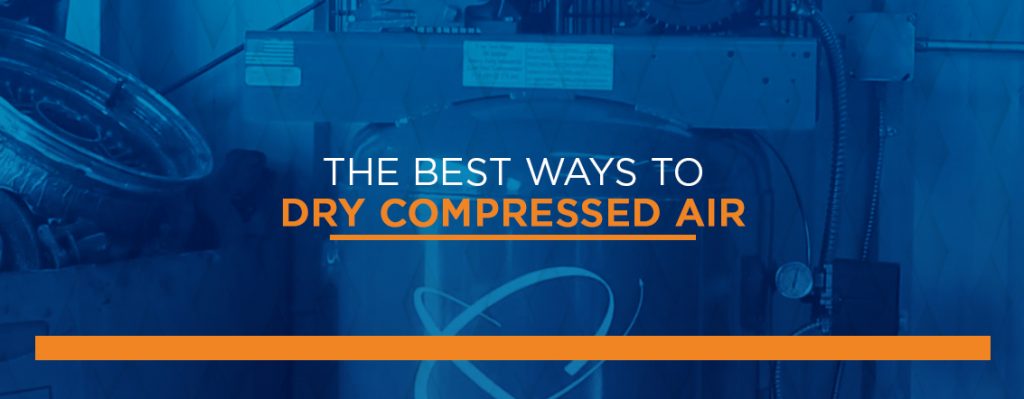
At that place'south water in the air all around u.s.a.. The moisture level in air changes as the temperature changes. For example, common cold winter air can experience drying to our peel, but a hot, boiling twenty-four hour period can create moisture in all kinds of unassuming places. Your hair may show signs of unruliness on a hot solar day due to the increased moisture in the air. Just what happens when this moisture builds up and your air compressor is full of water? Common practices to remove moisture from compressed air include:
- Draining the tank
- Using a h2o trap and filter regulator
- Using a refrigerated air dryer
- Using a desiccant air dryer
- Using a deliquescent air dryer
- Through piping organisation air drying
- With the storage tank cooling method
- Through assimilation drying
Why Is There Water in My Compressor?
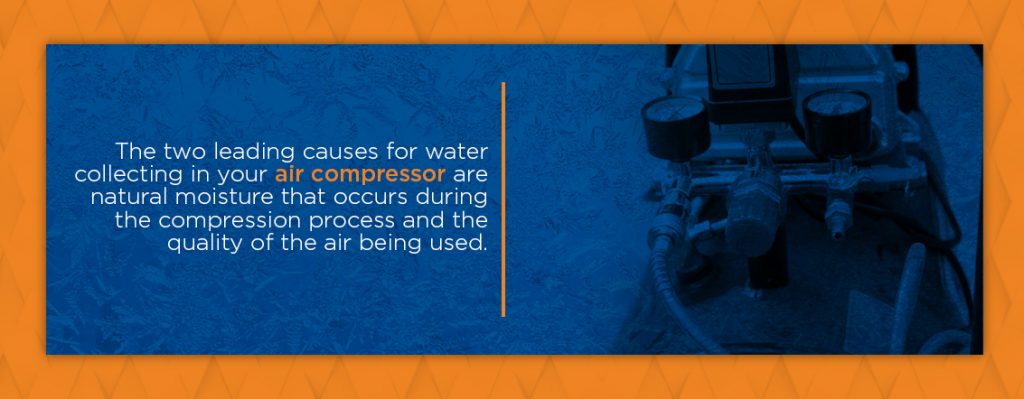
The two leading causes for h2o collecting in your air compressor are natural moisture that occurs during the compression process and the quality of the air being used. Your compressor's filtration arrangement works to divide pure air from other pollutants, including excess wet. The compressor filter traps that moisture and stores it away until it is dried or drained, leading to a natural build-up of water.
Both outdoor and indoor air contains a certain level of moisture or humidity. This percentage is influenced by factors such as:
- Air conditioning
- Running h2o
- Leaking roofs or windows
- Humidifiers
- Poor ventilation
Understanding Pressure Dew Point
We measure moisture in pressure dew signal (PDP), which refers to the temperature that the air would have to be at to achieve the same amount of dryness. In many industrial applications, a PDP of at least -40˚F (-40˚C) is desired, so the air is required to have the aforementioned moisture level that information technology would have at -40˚F.
The Danger of Having Too Much Moisture in Your Compressed Air
Although some level of wet is normal, too much h2o can:
- Damage your air compressor:When water builds up and remains stagnant in the aforementioned location, it can crusade rust to form, which will wear down your air compressor and contaminate your last production. The pressure from excessive wet in your tank will likewise put unnecessary strain on the compressor's parts, including the bearings, and prevent your tank filters from working correctly. When these parts go damaged, yous take chances costly repairs or an entire automobile replacement.
- Lower air quality:If yous are working in a heavily regulated industry, then you may no longer see set standards or quality codes if your compressed air is tainted with excess moisture.
- Event in a poor concluding product:Overly moist compressed air can create an junior final production. For example, wet compressed air tin warp woodworking projects, water down pulverization blanket and could atomic number 82 to rust formation on metal surfaces.
Removing excess water and moisture from your air compressor is crucial for the longevity of your car, also as the quality of your compressed air.
How to Remove Water From Compressed Air
Pressurized air needs some type of system or device to remove its naturally occurring moisture. Several options exist to remove water from your air compressor, which tin can be as elementary as a bleed valve on the tank or as complex equally a four-stage air drying system. You may be using compressed air for purposes that require moisture-complimentary output air. In this example, any existence of wet volition negatively impact your operations.
There are applications that can tolerate a low moisture content and won't need an elaborate air-drying setup. Either mode, air compressor moisture in your tank and lines is not ideal, so drying the air and releasing the water is absolutely necessary in some form.
For a compressor that delivers twenty liters of air per second, information technology also supplies 24 liters of h2o a day. Almost of that h2o needs to be removed, and it's usually washed in several stages. For example, an industrial air compressor that produces near 24 liters of water a day volition move the wet and hot compressed air to an aftercooler, which removes fifteen liters, and then to a refrigerated air dryer, which removes some other seven liters. At that place may be another phase with a desiccant air dryer for the driest air possible.
Air compressors are used for a broad range of applications, so there isn't one perfect solution to every dry out compressed air application. Libation air holds less water, so it uses many systems to cool the compressed air. This allows water to drop out of the air, and then it can exist nerveless and tuckered.
Draining the Tank
The first stage of keeping moisture out of your air lines is to drain your air compressor tank often. There's a bleed at the lesser of your air compressor pressure tank, which releases the water and oil mixture that collects at the bottom. This should exist done every time you use your air compressor to preclude rust building up on the inside of your tank and to go on wet out of your lines and tools.
If y'all avoid draining your tank because it's difficult to attain the drain valve, you lot should install a drain extension kit, and so it'due south easily attainable. You lot could too install an automatic tank drain with a timer that you can fix to periodically drain the tank for you. Either way, it's a matter of safety and essential.
Water Trap and Filter Regulator
Designed to work with incoming cool air, a water trap is a simple method of removing moisture from compressed air. The air enters one side, and and then it circulates around the bowl where the water collects at the bottom of the trap and drains out. The air will exit through a filter, which traps other impurities in the air.
A water trap is not generally used on its own, merely as role of a multi-step system to remove every bit much moisture from the air as possible. It is especially used for applications that require extremely dry air, such as painting, sandblasting or powder coating.
Refrigerated Air Dryer
Working in a similar way as an air conditioning unit, a refrigerated air dryer is continued to the air compressor and cools the air to a specified temperature, commonly between 35˚F to fifty˚F (1.5˚C to 10˚C). This results in a pressure level dew point (PDP) of 33˚F to 39˚F (0.5˚C to 3.eight˚C).
The water drops out of the air and is separated, then the air is heated up and sent through the lines for its end-use. Some applications crave a lower PDP, which would require a desiccant air dryer considering the condensate volition freeze at 32˚F (0˚C) and not be able to be removed. This is not i of the almost economic ways to dry compressed air, only it is one of the most efficient and has a complete drying organization in one unit of measurement.
There are two configurations of refrigerated air dryers: non-cycling and cycling.
Non-cycling refrigerated air dryers:
- Cool the compressed air in a heat exchanger
- Warm compressed air equally it travels in i side, while low-pressure level liquid refrigerant is metered on the other side of the heat exchanger
- Reduce the temperature of the compressed air as refrigerant is heated
- Regulate the flow of refrigerant as the heat load from the compressed air changes
Alternatively, cycling refrigerated air dryers:
- Cool the compressed air through a heat exchanger medium like sand, metal or a fluid
- Contain 2 oestrus exchangers fitted inside a tank that is filled with a thermal conducting fluid, such as h2o with propylene glycol added to prevent freezing and corrosion
- Remove heat from the thermal conducting medium using the refrigeration organization, so the compressed air is cooled past the thermal conducting medium
- Bike on when the fluid rises to its upper limit
- Are designed to exist more free energy-efficient than not-cycling designs because refrigeration is only used to cool the heat exchanger medium and not the constant period of hot air
- Use a simpler refrigeration circuitry than non-cycling because hot gas featherbed valves are not required
Desiccant Air Dryer
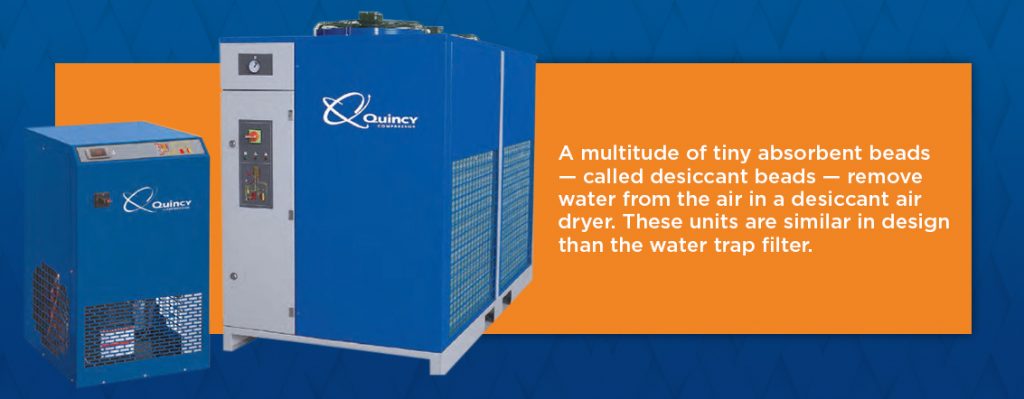
A multitude of tiny absorptive beads — chosen desiccant beads — remove h2o from the air in a desiccant air dryer. These units are similar in design than the water trap filter. The air goes through the centre of the pressure vessel, removing water equally it circulates. In one case the specified wet content is reached, the air is moved out of the dryer to the lines for its end-apply. A high-efficiency coalescing prefilter is needed to prevent harm from water and oil sludge.
Most desiccant dryers have two vertical pressure level tanks that continuously operate through a drying-regeneration cycle, referred to as a NEMA cycle. An instance setting may be a 10-minute NEMA cycle, where the unit is drying for five minutes, then regenerating for 5 minutes.
While the drying time cycles, the fully pressurized compressed air flows through the online desiccant vessel through a bed of desiccant beads that strip the water vapor and hydrocarbon molecules from the air. The compressed air is released from the vessel when the specified PDP is reached.
During the regeneration cycle, the vessel depressurizes, and the regeneration process begins to estrus the wet out of the desiccant. Subsequently regeneration, the tank is pressurized again and ready for its next drying cycle.
There are three common desiccants used:
- Silica gel:an amorphous grade of silica with superior water-vapor-arresting qualities that provide a PDP of -xl˚F to -85˚F
- Activated alumina: a porous form of aluminum oxide with silicon dioxide that provides a PDP of -twoscore˚F to -100˚F; the best option for heatless air dryers
- Molecular sieve: a porous grade of zeolites formulated to absorb specific vapor and gas molecules that provide a PDP of -100˚F and lower
Desiccant dryers are commonly found in industrial environments, where the highest amount of moisture needs to exist removed from the compressed air.
Quincy Desiccant Dryers
Quincy Compressor manufactures a full line of desiccant air dryer systems with dual towers that permit for purging — regeneration of the desiccant — in one tower while the other tower dries compressed air. This feature provides customers with longer use of the desiccant and continuous operation for extended periods, as in common in industrial environments.
Quincy offers four models of desiccant dryers to accommodate the various applications of air compressor systems.
The QHD Heatless Desiccant Dryer:
- Regenerates the off-line tower by using a small fraction of the stale compressed air
- Offers low maintenance costs and low initial cost
- Has an boilerplate-to-loftier operating cost
The QDHP Heated Purge Desiccant Dryer:
- Regenerates the off-line tower with half the amount of the compressed air every bit compared to the heatless series
- Offers low maintenance costs and fairly low operating costs
- Has an average initial cost
- Cuts free energy use past 50 percent with the optional Quincy MicroBurst Regeneration organisation
The QDBP Blower Purge Desiccant Dryer:
- Regenerates the off-line belfry past combining oestrus with ambient air
- Offers relatively depression maintenance costs and operating costs
- Has a high initial toll
The QMOD Heatless Modular Desiccant Dryer:
- Regenerates the off-line tower with a small fraction of the dried compressed air
- Offers low maintenance costs and initial toll
- Runs with moderate-to-high operating costs
Quincy air dryers purify your compressed air with our proprietary Q-Sorb desiccant product, which consists of an amplified compound of activated alumina. This formula facilitates absorption and a lower force per unit area drop, which helps to improve the energy efficiency of your air compressor over time.
If you're deciding between a heated or heatless desiccant dryer, remember this general dominion: heatless dryers are best for applications below two m scfm, and heated dryers are all-time for applications higher up two m scfm.
Deliquescent Air Dryers
Deliquescent air compressor dryers take a single tank and also use a desiccant, just they tin can simply provide a PDP of 20˚F to 25˚F lower than the air temperature entering the dryer. When the compressed air enters the tank, it reacts with the desiccant material to produce a liquid effluent that needs to be drained out of the dryer and disposed of co-ordinate to chancy waste material regulations.
These types of dryers are non used in industrial applications because the dried compressed air tin contain modest particles of the affluent, which would be corrosive to equipment down the line.
Piping Organisation Air Drying
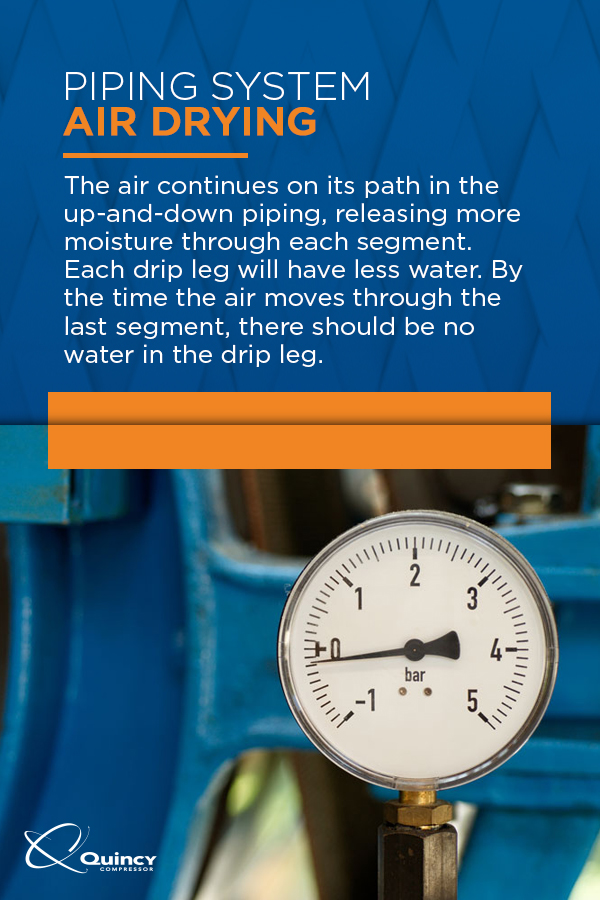
Y'all tin plumb your air lines to remove water from your compressed air. By using long lengths of metal pipe congenital into two or more up-and-down patterns, the air is cooled every bit the piping absorbs the heat. Reacting to gravity, the h2o drops down to the bottom of the piping organisation into a 'drip leg' or 'driblet leg' and is trapped, either by a water trap or a T-fitting and a ball valve.
The air continues on its path in the upwardly-and-down piping, releasing more than moisture through each segment. Each baste leg will accept less water. By the time the air moves through the last segment, there should be no h2o in the drip leg. This can be used as a stand-alone method of drying compressed air and is the most common and most cost-efficient way to dry compressed air in a shop for business organisation or personal use.
The virtually important elements of compressed air drying systems are as follows:
- Accept all the horizontal piping angling downwards, so the h2o moves along with the air every bit opposed to settling in the pipe. A minimum gradient of i in 100 is recommended.
- Add a drop leg whenever the pipe needs to be elevated or go vertical, and then gravity will motility the water down to the dip leg to exist removed.
- Add together a water trap or filter regulator at the finish of the pipage to remove any remaining water.
- Keep the drop legs away from electric sockets.
- Be aware of how much piping yous use and how much it will affect the pressure level drib. Use the Compressed Air & Gas Institute Installation Pipework computer to determine force per unit area drop and find other useful calculations for your compressed air system.
Storage Tank Cooling Method
Storage tanks, too known as air receiver tanks, human action equally a temporary storage reservoir to shop compressed air as it exits the air compressor. They are used in high-need projects that require a lot of compressed air with little fourth dimension to spare, including many industrial applications. The air storage tank pressurizes the compressed air to continue information technology usable. Receiver tanks tin can be used for either "wet storage" or "dry out storage:"
- Wet storage: Wet storage is when compressed air is held post-compression, merely before going through the air-drying process. This allows additional moisture to condense out of the compressed air before it always reaches the air dryer, which greatly minimizes the amount of h2o in the final issue.
- Dry out storage:Dry out storage is when the compressed air is stored in the receiver tank post-air drying, which protects the compressed air from gathering whatever additional moisture.
In both moisture and dry air storage, "arroyo temperature" plays a large office in reducing excess moisture. Approach temperature refers to the difference in temperature between the discharged air and the temperature of the interior of the storage tank. When the two unlike temperatures meet, the air begins the condensation process that expels moisture into the tank and out of the compressed air. It does this until the air in the storage tank reaches a steady temperature.
Assimilation Drying
If you're wondering what absorption drying is and why you might not have heard of it before, you are likely not alone. Absorption drying is a chemical process that uses absorbent materials — typically either water-soluble sodium chloride or sulfuric acid — to absorb excess moisture. This method of air compressor water removal is non used as often as other drying methods but is notwithstanding a feasible choice for the following reasons:
- Absorption drying has a depression initial cost compared to some other types of drying machines because information technology does not require purchasing boosted air drying equipment or tools.
- Maintenance is usually more straightforward due to the lack of moving or electrical parts involved.
- It is a uncomplicated process that requires lilliputian monitoring or involvement on your part.
In that location are also a few disadvantages to using absorption dryers, such as:
- The absorptive materials need to be re-added every time they deliquesce, which takes additional fourth dimension and coin.
- The absorptive materials might solidify or build-upwards, which could create a blockage problem in the tank.
- Residue from the materials may transfer into the other parts of your air compression or air drying machine.
- The dew point is not lowered as much as it is with other drying methods, pregnant at that place are more constructive drying methods available.
What to Consider When Ownership an Air Dryer for Your Compressor
If y'all are unsure what air compressor dryer to buy, the post-obit factors will affect which type of air dryer is best for you lot:
- Available utilities
- Dew signal requirement
- Operating pressure
- Inlet air temperature
- Ambient air temperature
- Airflow
The dew point requirement is the first matter to consider. Y'all may be able to eliminate some air dryers just by examining how much or piffling h2o needs to be removed for your application. You lot may need to consult a professional to determine the PDP for your applications. The ranges below indicate what blazon of dryer is best to achieve specific dew points:
- 0 F to 80 F – Deliquescent air dryer
- 0 F to 32 F – Refrigerated air dryer
- -40 F to 0 F – Desiccant air dryer with a silica desiccant
- -100 F to 0 F – Desiccant air dryer with activated alumina desiccant
Recall to consider the capacity (CFM rating) and the pressure (PSIG) of your air compressor. Y'all must choose the correct size for your compressed air drying system. It should be the correct size for your air compressor and awarding.
The purchase price is certainly one consideration, but the energy utilize and maintenance costs are also major deciding factors, equally well as the boosted price of the pressure level driblet that will occur equally your compressed air travels through another organization. You will demand to run your compressor at a slightly higher pressure with an air dryer to recoup for the loss of pressure through piping or run information technology with a dryer unit to achieve the same pressure for end-use.
Desiccant air dryers with two towers will regenerate the desiccant in various means, so this is also something to analyze as your operating costs will be significantly afflicted depending on where the energy is coming from.
How to Go along Moisture out of Your Air Compressor
Because the air pinch and filtering process results in natural moisture, it is not possible to prevent all moisture from getting into your air compressor. Yet, there are a few steps you can take to forestall excess moisture from edifice upward and go along your compressor as dry as possible:
Minimize Unnecessary Moisture in Your Workspace
Fifty-fifty when you work indoors, in that location is always a level of wet present in the air around you lot. Luckily, there are several steps y'all can take to minimize unnecessary moisture in the air:
- Ensure acceptable ventilation:Make sure the room and building you work in are fairly ventilated, so airflow can help expel naturally-occurring moisture.
- Use fans:Both standard fans and exhaust fans will help dry the air in your workshop or warehouse. Assuming the additional airflow volition not hinder your work operations or stop product, install and identify them in the area where compressed air is used and stored.
- Fix leaks and structural issues:Leaks in your walls, windows, plumbing and flooring can lead to undetectable continuing water and create additional moisture in the room.
- Invest in a dehumidifier: Dehumidifiers are machines you place in your room or building to reduce the amount of humidity and moisture in the air. This besides helps foreclose mold and mildew formation and helps keep energy costs low.
- Eliminate standing water:Immediately eliminate all sources of standing water in the room that houses your air compressor, including areas that are moisture from leaks or spills.
- Clean your air conditioning filters:If your building uses an air conditioning system, clogged or cleaved filters can lead to excess humidity. To prevent this, have your filters checked and inverse regularly by a professional person.
- Install insulation:Install insulation in your building's walls, floors and effectually all windows and doors. Insulation will keep your space at a more abiding temperature and volition forestall cool or damp air from seeping indoors and causing water build-upwards in air compressors.
- Check the weather and plan ahead:Humidity in the air translates to excess moisture in your air compressor lines. Pre-plan or schedule air compressor operation for a time of day that is non equally humid or when the dew point is at its lowest. For example, think about the dew that you see on the grass in the early morning — it's usually gone by the early afternoon. Have your planning a stride further and check the weekly weather forecast to see which days are going to be drier than others, which includes fugitive rainy days or days with a lot of fog.
- Use a larger air compressor: If your air compressor is too pocket-size, it volition likely overheat as information technology tries to go on up with the demand. As the temperature inside an undersized tank begins to ascension, moisture will form. Eliminate this concern by investing in a larger air compressor, or using multiple smaller systems to get the job done.
- Use and maintain compressor air filters: Air compressors require a filtration system to separate pollutants and contaminants from pure air, including water and moisture. Make certain you are using a high-quality air filtration organization with your compressor, and that it is fitted correctly to your machine. Once installed, you must regularly inspect and clean your filters. Supervene upon your filters regularly and when damaged.
- Bleed your air compressor regularly: Just above the drainage area is where all removed droppings — including particles, oil and excess moisture — are stored when separated by your tank's filter. The drain needs to be emptied to avoid rust, clogs, dorsum-up and to improve functioning. Remember to do this after every apply to continue moisture out of your air compressor.
- Schedule preventive maintenance checkups: Preventive maintenance is the all-time style to keep your air compressor running finer for as long every bit possible. Preventive maintenance can allow a technician to catch issues earlier they abound into more significant, costly problems later on. It likewise minimizes the chance you volition have to cease operations in the event of a compressor break downwards or repair.
- Supercede your air compressor when necessary: Quality air compressors are designed to concluding a long fourth dimension, but that doesn't mean they won't somewhen need to exist replaced. If you are having trouble with excessive wet, noticed additional concerns that repairing has non stock-still or if a service technician has recommended it, consider a auto replacement.
Quincy Compressor's Air Dryers
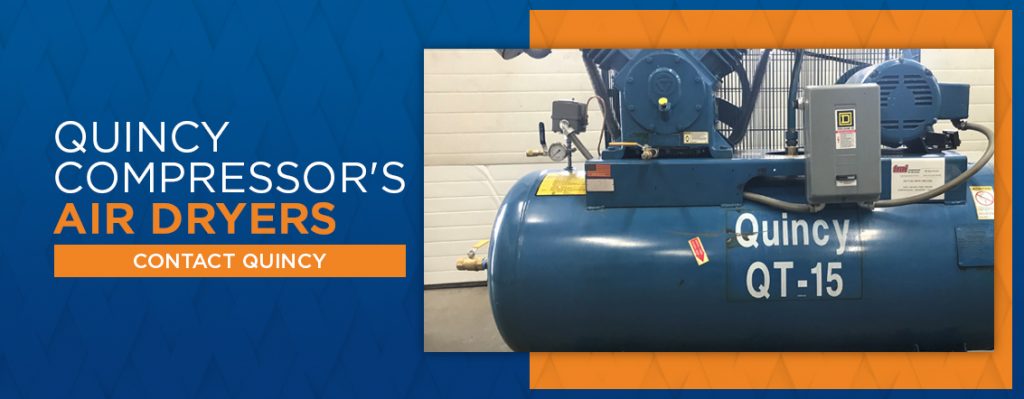
Need more information about how to dry compressed air? Contact Quincy or locate a sales and service representative near you. Nosotros'll help you lot find the best air dryer for your air compressor organisation.
Last Updated on May iv, 2022 at vii:45 am
Source: https://www.quincycompressor.com/the-best-ways-to-dry-compressed-air/

0 Response to "How To Build A Water Trap For Air Compressor"
Post a Comment